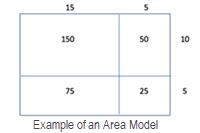
Using Visuals to Develop Conceptual Understanding: Area Models is a half-day, face-to-face workshop designed to help adult numeracy teachers understand how to use visual models across the levels and domains in the College and Career Ready Standards for Adult Education (CCRSAE). Area models and arrays are wonderful tools to help students see how the basic properties of addition and multiplication work, from whole numbers to binomials.
- Adult numeracy teachers at all levels of math experience and confidence
This professional development activity/course is designed for:
Have you ever wondered how area models can help students understand math (or what they even are)? Having this tool on hand can help students feel like they don’t have to memorize new steps for every math function. Join us for an exploration session connecting CCRSAE concepts Levels A through D with area models.
Area models help us see the structure of math. According to Adding It Up: Helping Children Learn Mathematics (NRC), the area model "summarizes the steps in multi-digit multiplication" (p. 207). In doing so, students can begin to visually see why the standard U.S. algorithm for multiplication works. For our adult learners who still struggle to understand multi-digit multiplication, area models can be the perfect tool. In understanding the area model for whole numbers, students can then move developmentally through fractions and decimals and even to binomials.
According to Boaler et al. in Seeing as Understanding: The Importance of Visual Mathematics for our Brain and Learning (2016), “It seems possible that visual mathematics may contribute to equity, in valuing students’ thinking in different ways, as well as encouraging deep engagement, as we have found all students to be excited to see math ideas, and from there they have developed higher levels of understanding and performance.” (p. 10). Not only does her team suggest that visualizing math helps all students (including LD students) to better understand math concepts, they also found when teachers were given visual experiences they gain insights into mathematical concepts as well.
This is a 4-hour workshop. To receive a certificate of completion, participants must attend the entire face-to-face-session. For more information, please contact Sherry Soares (sherry_soares@terc.edu).
- Boaler J., Chen L., Williams C., & Cordero M. (2016). Seeing as Understanding: The Importance of Visual Mathematics for our Brain and Learning. J Appl Computat Math 5: 325. doi: 10.4172/2168-9679.1000325
- National Research Council (NRC) (2001). Adding It Up: Helping Children Learn Mathematics. Washington, DC: The National Academies Press. https://doi.org/10.17226/9822.
-
Identify the math concepts associated with area models
Give examples of how area models can be used to develop number and operation sense
Use area models to teach in a more conceptual way
Describe the developmental continuum for using area models with students
Upon completion of this professional development activity/course, you will be able to:
N/A
Holyoke CC / Picknelly Adult and Family Education Center
206 Maple Street, Room 402
Holyoke, MA 01040
United States


